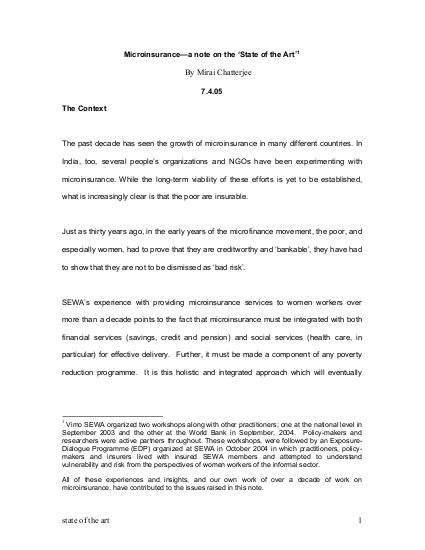
The past decade has seen the growth of microinsurance in many different countries. In India, too, several people’s organizations and NGOs have been experimenting with microinsurance. While the long-term viability of these efforts is yet to be established, what is increasingly clear is that the poor are insurable. Just as thirty years ago, in the early years of the microfinance movement, the poor, and especially women, had to prove that they are creditworthy and ‘bankable’, they have had to show that they are not to be dismissed as ‘bad risk’. SEWA’s experience with providing microinsurance services to women workers over more than a decade points to the fact that microinsurance must be integrated with both financial services (savings, credit and pension) and social services (health care, in particular) for effective delivery. Further, it must be made a component of any poverty reduction programme. It is this holistic and integrated approach which will eventually reduce vulnerability and stem the decapitalisation that occurs when risks and crises confront poor families. Our experience leads us to an understanding of microinsurance that places it at the frontier of both financial services and social protection, incorporating elements of both. Like other microfinance services, it must be run in a financially viable manner, but it needs the universalisation that comes with the social protection approach. Universalisation—making insurance available to all citizens regardless of socioeconomic status-- or at least maximizing coverage to include as many citizens as possible, and especially the poorest, is not only equitable, but also makes ‘good business sense’ from an insurance viewpoint. The larger and more diverse the pool of insureds, the greater is the spread of risk and, consequently the greater the chances of viability.
Resource collections
- UN Habitat - Urban Response Collection
- Urban Response - Urban Crisis Preparedness and Risk Reduction
- Urban Response Collection - Community Engagement and Social Cohesion
- Urban Response Collection - Economic Recovery
- Urban Response Collection - Environment and Climate Change
- Urban Response Collection - Housing, Land and Property
- Urban Response Collection - Urban Crisis Response, Recovery and Reconstruction
- Urban Response Collection - Urban Resilience
